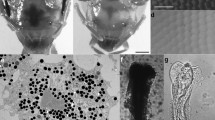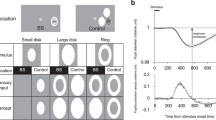Summary
-
1.
Intracellular recordings of acceptance angles were made at different adaptation states and at different times of day, from retinula cells in the central region of the reflecting superposition eye of the freshwater crayfish,Cherax destructor (Clark 1936). A number of cells were held for longer than 24 h.
-
2.
The acceptance angle is greater in the dark-adapted (DA) state than in the light-adapted (LA) state, but this difference is significantly smaller at night than during the day. Mean values were 5 ° (LA day and night), 19 ° (DA day) and 13 ° (DA night).
-
3.
The anatomy was studied with proper attention to the time of day. Light microscopy shows that there is an increase of 10–15% in the clear-zone width in the DA state at night compared to the other states. This is achieved by a proximal movement of the rhabdom layer.
-
4.
The position of the distal screening pigment depends on the ambient light level. It is around the distal cones in the dark and moves into the clear zone on light-adaptation. The proximal screening pigment, however, attains only the first stage of dark-adaptation (Frixione et al. 1979) during the day. Complete dark-adaptation (movement below the basement membrane) occurs only at night. The distal reflecting pigment remains around the cones at all times, and the proximal reflecting pigment forms a cup around the base of the rhabdom during both day and night.
-
5.
The smaller acceptance angle in the DA state at night, compared to that of the DA day state, indicates that the receptors lie closer to the best superposition focus in this state, when the animal is in air.
-
6.
The effect of the change in clear-zone width and the performance of the eye in air and under-water are examined using a model of the eye.
Similar content being viewed by others
Abbreviations
- LA :
-
light adapted
- DA :
-
dark adapted
References
Bennitt R (1932) Diurnal rhythm in the proximal pigment cells of the crayfish retina. Physiol Zool 5:65–69
Bryceson KP (1981) Focusing of light by corneal lenses in a reflecting superposition eye. J Exp Biol 90:347–350
Bryceson KP (1983) Diurnal changes in photoreceptor sensitivity in a reflecting superposition eye. J Comp Physiol (in press)
Bruin GHP de, Crisp DJ (1957) The influence of pigment migration on vision of higher Crustacea. J Exp Biol 34:447–463
Burkhardt D, Streck P (1965) Das Sehfeld einzelner Sehzellen: eine Richtigstellung. Z Vergl Physiol 51:151–152
Caveney S, McIntyre, P (1981) Design of graded-index lenses in the superposition eyes of scarab beetles. Philos Trans R Soc Lond [Biol] 294:589–635
Clark E (1936) The freshwater and land crayfishes of Australia. Mem Nat Mus Vict 10:5–58
Dreisig H (1981) The dynamics of pigment migration in insect superposition eyes. J Comp Physiol 143:491–502
Exner S (1891) Die Physiologie der facettirten Augen von Krebsen und Insecten. Deuticke, Leipzig Wien
Frixione E, Aréchiga H, Tsutsumi V (1979) Photomechanical migrations of pigment granules in insect superposition eyes. J Neurobiol 10:573–590
Hafner GS, Hammond-Soltis G, Tokarski T (1980) Diurnal changes of lysosome-related bodies in the crayfish photoreceptor cells. Cell Tissue Res 206:319–332
Horridge GA, Giddings C, Stange G (1972) The superposition eye of skipper butterflies. Proc R Soc Lond [Biol] 182:457–495
Horridge GA, McLean M, Stange G, Lillywhite PG (1977) A diurnal moth superposition eye with high resolutionPhalaenoides tristifica (Agaristidae). Proc R Soc Lond [Biol] 196:233–250
Horridge GA, Duniec J, Marcelja L (1981) A 24-hour cycle in single locust and mantis photoreceptors. J Exp Biol 91:307–322
Kleinholz KH (1966) Hormonal regulation of retinal pigment migration in Crustaceans. In: Bernard CG (ed) Functional organization of the compound eye. Pergamon Press, Oxford, pp 89–101
Kunze P (1969) Eye glow in the moth and superposition theory. Nature 223:1172–1174
Land MF (1976) Superposition images are formed by reflection in the eyes of some oceanic decapod Crustacea. Nature 263:764–765
Land MF (1978) Animal eyes with mirror optics. Sci Am 239:88–99
Land MF, Burton FA, Meyer-Rochow VB (1979) The optical geometry of euphausiid eyes. J Comp Physiol 130:49–62
Nässei DR, Waterman TH (1979) Massive diurnally modulated photoreceptor membrane turnover in crab light and dark adaptation. J Comp Physiol 131:205–216
Olivo RF, Larsen ME (1978) Brief exposure to light initiates screening pigment migration in retinula cells of the crayfish Procambarus. J Comp Physiol 125:91–96
Scholes J (1969) The electrical responses of the retinal receptors and the lamina in the system of the fly Musca. Kybernetik 6:74–79
Snyder AW (1977) Acuity of compound eyes. Physical limitations and design. J Comp Physiol 116:161–182
Stowe S (1980) Rapid synthesis of photoreceptor membrane assembly of new microvilli in a crab at dusk. Cell Tissue Res 211:419–440
Vogt K (1975) Zur Optik des Flußkrebsauges. Z Naturforsch 30c:691
Vogt K (1977) Ray path and reflection mechanisms in crayfish eyes. Z Naturforsch 32c:466–468
Vogt K (1980) Die Spiegeloptik des Flußkrebsauges. J Comp Physiol 135:1–19
Walcott B (1974) Unit studies on light-adaptation in the retina of the crayfishCherax destructor. J Comp Physiol 94:207–218
Welsh J (1941) The sinus gland and 24 hour cycles of retinal pigment migration in the crayfish. J Exp Zool 86:35–49
Williams DS (1982) Ommatidial structure in relation to turnover of photoreceptor membrane in the locust. Cell Tissue Res 225:595–617
Wilson M (1975) Angular sensitivity of light and dark adapted locust retinula cells. J Comp Physiol 97:323–328
Author information
Authors and Affiliations
Rights and permissions
About this article
Cite this article
Bryceson, K.P., McIntyre, P. Image quality and acceptance angle in a reflecting superposition eye. J. Comp. Physiol. 151, 367–380 (1983). https://doi.org/10.1007/BF00623912
Accepted:
Issue Date:
DOI: https://doi.org/10.1007/BF00623912




